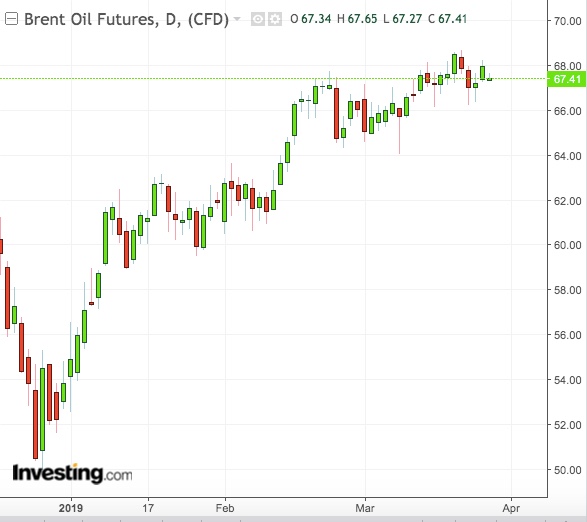Deep within its unprecedented cooperation with Russia on oil production cuts is Saudi Arabia’s conviction that, in order to get the price per barrel it wants, it can afford to put its own market share at peril.
An ability to come back from the brink twice in its battle with U.S. shale—the first between 2017 and the middle of last year, and again since the beginning of this year, with Russia on its side both times—has given Riyadh the confidence that it it can make $80 or more from a barrel of oil.
Political history is on the Saudi's side too. From literally getting away with murder—the slaying of the journalist Jamal Khashoggi has hurt the reputation of Crown Prince Mohammed bin Salman more than the fortunes of the Kingdom—to the relatively small price it has paid thus far for its role in the Yemen war, Saudi Arabia was emboldened into believing it can push the reset button on just about anything.
Audacious Oil Gamble
That explains the Kingdom's current gamble on oil—one of the most audacious in the six decades of managing the oil producers club OPEC. Headlines gush about U.S. crude exports hitting record highs of 3.6 million barrels per day and of major Asian customers like Indian Oil (NS:IOC) buying from the U.S., while Saudi production is expected to fall about 30% below norm next month, to under 7 million bpd.
Despite U.S. crude production having tapered off its highs over the past month, the implied threat to the Saudi market share is all there. Yet, Energy Minister Khalid al-Falih, in his speeches, harps only about the need for “market rebalancing”, which is Saudi-speak for higher oil prices.
John Kilduff, founding partner at Again Capital, an energy hedge fund in New York, says Falih’s response is a mix of swagger, as well as averseness in admitting to the potential of shale’s outreach. The U.S. Energy Information Administration predicts that the United States will produce more oil than Saudi Arabia and Russia combined by 2025, a forecast Riyadh has so far maintained an elegant silence on. Falih, on his part, announced a historical high in proven Saudi oil and gas reserves at the start of the year.
Said Kilduff:
“Right now, the Saudis still believe they have power to be the swing producer of oil and to manage its price. But they are taking a big chance here with the competition coming from shale.”
As example, Kilduff cites the Louisiana Offshore Oil Port, which loaded 11 VLCCs in its first year of direct exports, with 60% of those cargoes going to India and 23% to China.
He added:
“It’s not just light crude that we’re talking about here. The exports from the LOOP are said to include condensates, and heavier U.S. crude grades like Mars that’s comparable to Middle East oil.”
Rivals In Shale Include Big Oil
Then, there’s the specter of stiffer rivalry from industry behemoths like Exxon Mobil (NYSE:XOM), which claims the ability to make double-digit profit from prices as low as $35 per barrel in the most prolific U.S. shale basin, the Permian.
Exxon, which together with "Big Oil" peer Chevron (NYSE:CVX) plans to extract another 1 million bpd each from the Permian, is also seeking to discover shale at $15 a barrel—a price hitherto possible only in the Middle East.
But some, like Phil Flynn of the Price Futures Group in Chicago, believed shale’s potential is overhyped.
Said Flynn:
“I don’t think the Saudis are worried at all. They can get back market share by offering crude at the right price in the markets they want.”
He added:
“The Saudis know that they and the Russians are still the biggest guys in the business now, and they can turn the spigots off anytime they want and send the price gushing. They don’t have limitations the way the shale guys have to produce.”
Economy, Venezuela and Trump Could Decide Saudis’ Bet

Be that so, there are three things over the next year that could decide if the Saudis get to bring global oil benchmark Brent to their top desired price of $80-$85 a barrel—or at least $70. Those three are the economy, Venezuela’s political crisis and U.S.President Donald Trump.
A recession scare in the U.S. and fear of an economic slowdown stretching from Asia to Europe sent oil prices plummeting earlier this week as investors worried about demand for energy. Global macro data has been steadily eroding since the start of the year, although they could improve over time if China issues adequate stimulus measures, notwithstanding its trade war with the U.S.
A resolution on Venezuela could also return to the U.S. the heavy oil much needed by domestic refiners, countering some of the OPEC cuts.
The Trump factor is more complicated.
Politically re-energized after being cleared of accusations that he colluded with Russia on his 2016 election campaign, the president could be in the mood for another high-stakes battle with OPEC to fight high oil prices. And his range of responses could run the gamut, from his favorite tweeting option to granting generous sanction waivers for buyers of Iranian oil, and even selling emergency U.S. oil stockpiles.
Trump has a cozy yet awkward relationship with the Saudis, stressing the need for the U.S. to defend its important ally in the Middle East—which included not acting against Riyadh for the Khashoggi murder. Yet the president needs to ensure he keeps pump prices of oil low enough to appeal to his base ahead of his re-election bid in November 2020.
That’s 20 months away, and that’s a long time in the oil market.
